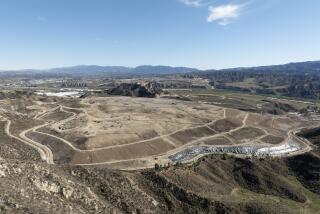Proposed Landfill for 19th-Century River Town Stirs Opposition : Ruins of Village Symbolize Slaves’ Flight to Freedom
- Share via
KANSAS CITY, Kan. — When Orrin Murray was a little boy, his father would take him in the buggy down to old Quindaro. It was a ghost town even then, a collection of brick and limestone buildings overgrown with weeds.
Scavengers had carted away much of the town piece by piece and mudslides had buried much of what was left, but Murray’s father would point out what landmarks could still be seen.
That building over there, he would say, used to be the old hotel, and these walls over here are all that is left of the brewery.
Then he would tell the story of how young Orrin’s grandfather had escaped from slavery in Missouri by putting his family into a stolen skiff and leading it across the Missouri River to Kansas.
They landed in Quindaro, a tiny boom town that soon would cease to exist but would be unearthed nearly 100 years later, when a state archeologist would call it “the Pompeii of Kansas” because of what it could reveal about the state’s early history.
Father ‘Born Free’
“Six months after they crossed, my father was born, him being the only one of six children who was born free,” said Murray, who is 88 and lives a few blocks from the town’s ruins. “He would’ve been a slave if his father hadn’t escaped.”
Quindaro was a station on the Underground Railroad, the route abolitionists established to help slaves flee the South. To black escapees from the slaveholding state of Missouri, the town of Quindaro and freedom were one and the same.
During its seven years of existence, from 1855 until 1862, the river town also was central to the bloody battles fought between slavery and anti-slavery forces in Kansas just before the Civil War, and it played an important role in the settlement of the territory before statehood.
Now, Quindaro is at the heart of another battle. Browning-Ferris Industries, a large, Houston-based waste-disposal company, wants to put a sanitary landfill on the slope where the ruins stand. The plan has brought strenuous opposition from those who consider the site as important a symbol of American values and history as Ellis Island or the Statue of Liberty.
“Quindaro is important to the history of the United States in the 19th Century,” said Fred Whitehead, an amateur historian who is part of a group fighting to save the ruins. “It was central to what we are as citizens of this country. It just seems to me beyond comprehension that they would want to put a landfill there.”
The ruins are on a steep slope in northwestern Kansas City, on the edge of a working-class black neighborhood and near a 77-year-old statue commemorating the abolitionist militia leader John Brown. The town site still is overgrown with brush and littered with trash.
Until the current dispute began, most Kansans knew nothing of the town, but to the blacks of the community that sprung up around it, the site has always had profound, if largely personal, significance.
Lore Told to Children
“We grew up knowing about the history,” said Marie Ross, who was born near the ruins and used to play there as a child early in the century. “We heard a lot of stories about the Underground Railroad . . . . It was just part of history. Nobody got excited about it. It was just there.”
Actually, quite a few people got excited about Quindaro down through the years. There have been sporadic attempts to preserve the ruins and have the area declared a historic site. In 1937, a bill to preserve Quindaro as a county park failed by one vote in the state Senate.
Whitehead, who is white, has an explanation for the failure to preserve the site. He said: “For all of Kansas’ identification with the free state cause and all that, there has been a tremendous amount of racism in the state, as in any other state.”
The fight against the landfill has the support of environmentalists who say that dumping beside the Missouri River, just upstream from the intakes of two water purification plants, could jeopardize the water supply of the metropolitan area and pollute much of the Mississippi River as well.
“That is the important thing here,” Gerald Lee of the Conservation Federation of Missouri said. “They know (the landfill) is going to leak. Everybody knows it’s going to leak.”
State public health and environmental officials have attached numerous conditions to the landfill permit. According to a state report on water contamination and pollution problems, officials acknowledge risks, “but they also think that the conditions they have imposed will minimize the risks.”
Lee said he is worried, however, that the landfill will be used to dispose of pesticides and new chemicals with unknown effects.
Quindaro was founded in 1855 by a group of Wyandotte Indians and abolitionists from New England. It was named for the Indian wife of one of the town’s founders.
In the mid-1800s, many of the early Kansas Territory settlers were abolitionists who came to join the crusade to make sure Kansas entered the Union as a free state. Under the rule of popular sovereignty, residents of the territory would determine whether slavery would be permitted. The times were violent, and guerrilla warfare between pro-slavery and anti-slavery groups won the state the nickname “Bleeding Kansas.”
Free-State Port of Entry
Quindaro was a safe port for free-staters coming to the territory from the east, and it is widely believed to have been the first free station along the Underground Railroad. Tales of how runaway blacks were hidden in cisterns and in caves abound.
Orrin Murray says that a road through Quindaro’s black community was called Happy Hollow Road “because they were so happy they’d escaped.”
To what degree Quindaro functioned as a station of the Underground Railroad is open to debate. An archeologist hired by Browning-Ferris has said the town’s historical significance has been exaggerated. The state historical society could find little substantiation that escaping slaves were hidden there in large numbers.
A 1956 issue of the Kansas Historical Quarterly, however, quoted a former resident of Quindaro as saying in an 1882 letter to a newspaper that many escaped slaves were harbored in the town.
The historical society’s report concluded that Quindaro was of historical importance to black Kansans and was important to understanding the history of the state “regardless of the degree to which Quindaro functioned as part of the Underground Railroad, and regardless of what abolitionist personages, if any, are associated with the site.”
Civil War Upheaval
The town, which never had more than 800 residents, was abandoned around the start of the Civil War. Economic depression in the late 1850s had driven out many of the townspeople, and when the war began in 1861, young men left to enlist in the Union army. Border strife drove their families away. The state revoked the town’s charter in 1862.
Blacks leaving Missouri came to settle in the surrounding area about this time. After the war, hostility toward former slaves in the South caused an exodus of blacks, and many came to Kansas. A school for ex-slaves, which became Freedman’s University and later Western University, helped attract them to the area. The town site remained largely unused, however.
The current push for preservation began in 1983, when the City Council and the African Methodist Church leased the land to Browning-Ferris Industries. The City Council granted a permit for a landfill, but on the condition that the company undertake an archeological survey and determine the site’s historic significance.
That survey found the neglected remains of the town and a number of 19th-Century artifacts.
Deadline for Purchase
After years of court battles and appeals to the city, what will become of the ruins remains undecided. The Kansas City, Kan., City Council voted to allow Browning-Ferris to bulldoze the ruins and start preparing the site for the landfill on June 1, 1989, unless funds are found for the state to purchase the land by then. Municipal officials say the city is in financial straits and cannot assist.
The Kansas State Historic Society on Oct. 28 voted to recommend to the governor and legislative leaders that the state purchase the site. Members of the state-supported agency stressed, however, that they did not want the cost taken from their budget.
Melvin Robinson, a leader of efforts to save the ruins, said foes of the landfill are planning fund-raising events to help with the purchase. Meanwhile, they are hoping that a resolution to be considered by Congress will provide help. Rep. Jan Meyers (R-Kan.) introduced the resolution Oct. 20, before Congress adjourned, to place Quindaro among the potential historic sites and parks being considered for federal matching funds under a proposed American Heritage Trust Fund.
Acquisition of the town site is expected to cost up to $3 million, and perhaps an additional $2.5 million to reimburse Browning-Ferris for the archeological studies.
More to Read
Sign up for Essential California
The most important California stories and recommendations in your inbox every morning.
You may occasionally receive promotional content from the Los Angeles Times.












